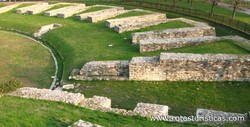Ciudad Romana de Aquincum (Budapest)
Budapeste . Margitsziget Island . Hungria





From the first century BC to the fifth century AD, western Hungary was part of the Roman Empire. It was called Pannonia, and its largest town was Aquincum, the ancestor of Budapest. As the center of Pannonia, Aquincum played an important leading role. The excavated ruins date back to the second century, when the city had around 15,000 inhabitants. Remains of an amphitheater, mosaic floors, tombstones, statues and a reconstructed water-organ are the main attractions.
The first Roman ruins were found in 1778 by a wine maker. Luckily, the significance of the find was recognized immediately, and the remains were shortly identified as the Roman town of Aquincum. Since then, more of the area has been excavated; however, so far only one third of the former settlement has been unearthed. Besides Aquincum, Hercules Villa (accessible only as part of a guided tour) and Thermae Maiores (Big Bath, a former Roman bath complex) are open to the public.
Aquincum is located in the oldest part of Buda, called Óbuda, which literally means Old Buda. Óbuda was united with Buda and Pest in 1873. Today, Óbuda forms part of District 3. In addition to the several excavated Roman ruins, Óbuda also has a Baroque and a modern side. Its center, Fő tér (Main Square), is one of the most charming squares in the city. Budapest's Shipyard Island, which hosts the biggest annual music festival, the week long Sziget festival, is also in this part of the city.
Getting to Aquincum: Take the HÉV (suburban railway) from Batthiány Square (at the M2 Subway station) to Aquincum
The first Roman ruins were found in 1778 by a wine maker. Luckily, the significance of the find was recognized immediately, and the remains were shortly identified as the Roman town of Aquincum. Since then, more of the area has been excavated; however, so far only one third of the former settlement has been unearthed. Besides Aquincum, Hercules Villa (accessible only as part of a guided tour) and Thermae Maiores (Big Bath, a former Roman bath complex) are open to the public.
Aquincum is located in the oldest part of Buda, called Óbuda, which literally means Old Buda. Óbuda was united with Buda and Pest in 1873. Today, Óbuda forms part of District 3. In addition to the several excavated Roman ruins, Óbuda also has a Baroque and a modern side. Its center, Fő tér (Main Square), is one of the most charming squares in the city. Budapest's Shipyard Island, which hosts the biggest annual music festival, the week long Sziget festival, is also in this part of the city.
Getting to Aquincum: Take the HÉV (suburban railway) from Batthiány Square (at the M2 Subway station) to Aquincum
| Compartido por: Cristina Nascimento | Aún no hay comentarios |
| Vistas: 8538 | |
Comparta los lugares de interés para visitar, los lugares que visitó en sus vacaciones o los lugares en su ciudad natal que desea promocionar.
Coordenadas GPS
Lat : 47.56352514582814 - Lon : 19.052245616912842
N47° 33' 48.690524981304 " E19° 3' 8.0842208862312"
Comentarios
Aún no hay comentarios para
Ciudad Romana de Aquincum (Budapest)
Se conoces Ciudad Romana de Aquincum (Budapest) Deja su comentario
Ciudad Romana de Aquincum (Budapest)
Se conoces Ciudad Romana de Aquincum (Budapest) Deja su comentario
GRACIAS

